|
|
GENETICS CAN BE FUN - part 2
Aug 9, 1996
by
DR. BRUCE M CATTANACH
Part 1 of this article described the cross of a Boxer with Pembroke Welsh Corgi having an inherited bob-tail. A primary object was to determine if through a series of backcrosses the Corgi bob-tail gene could be introduced into the Boxer. Here, the results of backcrossing two Corgi x Boxer crossbred bitches to a Boxer are described.
THE FIRST BACKCROSS: EXPECTATIONS AND ODDS
As both the crossbred dams and Boxer sire were fawn, all the pups were expected to be likewise, and all should have dominant black mask of the Boxer. However, all the main Corgi-Boxer differences (leg length, coat length, ear carriage) as well as tail type should separate out among the offspring. Moreover, because the Boxer sire, Foreign Service, carries the gene for white and the crossbreds carry both the Boxer and Corgi forms of the gene, further complexity regarding white markings was anticipated. It is perhaps best to present the expected outcomes in terms of the odds of their occurrence:
- To take the project into the next generation, and also for practical and economic reasons, it was necessary to keep a bitch. Therefore, from the 16 puppies obtained in the backcross, only 8 on average might be expected to be bitches.
- Any bitch to be of use for further breeding must, of course, have a bob-tail. Therefore, with a dominant inheritance, it could be expected that only half the pups would inherit the gene from their crossbred dams. Thus, of the possible 8 bitches, perhaps only 4 could be expected to have bob-tails.
- Because of all the difficulties in mating short and long legged dogs, I desperately wanted any bob-tail bitch which I was lucky enough to get to have long legs. Again, only half of the possible 4 of interest might have this characteristic; maybe 2 out the original 16!
- Then there was the coat length; only half again. Therefore, if I wanted to the short coat too, there would be only 1 chance in 16 of getting the combination wanted, a bitch with bob-tail, long legs and short coat. And this is without the white markings problem. Adding this:
- one-quarter of the pups were expected to be white, with the risk of deafness that this would entail;
- one-quarter were expected to show the piebald level of white marking like the crossbred dams;
- one-quarter were expected to have flashy white markings like the sire; and,
- one-quarter were expected to be near-solid, but carry the gene for the Corgi type of white markings.
THE RESULTS
At birth, the pups appeared to range from Boxer type to Borgy (Fig.8) and we could, of course, immediately recognise tail length; 7 had bob-tails (almost all of docked Boxer length and straight) and 9 had normal length tails. None had any unwanted abnormalities. And importantly, 4 of the bob-tails were bitches. So we were off to a good start.
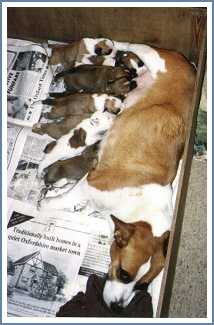
|
In all, the base colour was fawn with black mask. The white markings were of the four expected types. Two pups were white, 4 were of the piebald type, 8 were flashy and 2 were near-solid. However, what stunned us most was that some of the pups looked like pure bred Boxers of pick of litter quality (Fig.9).
I was desperate to have one like this with a bob-tail but, frustratingly, these had long tails. |
| |
|
Fig. 8 Crossbred Dolly and backcross litter; a range of types |
|
Fig. 9 Backcross pups (1/4 Corgi) of Boxer pick of litter quality |
By about 4 weeks we could distinguish different leg lengths. There were 8 of each type and this could be better seen at yet greater ages. It was clear that the pups either had Boxer length legs or short legs. But leg length, tail length and colour were inherited independently to give all possible combinations. At 6 weeks the two litters contained puppies that seemed like a collection of different breeds (see examples in Figs 10-13).
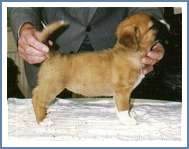 |
|
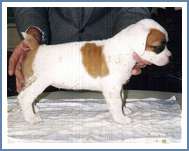 |
Fig. 10 Boxer markings, short legs, longish coat, long tail. |
|
Fig. 11 Piebald white markings, short legs, short coat, bob-tail. |
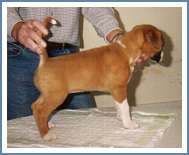 |
|
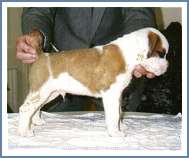 |
Fig. 12 Boxer markings, long legs, short coat, long tail. |
|
Fig. 13 Boxer conformation, piebald white markings, long legs, long coat, bob-tail. |
Yet luck was with us for we did manage to get the critical combination of characters we wanted, even in this first backcross generation. Thus, of the 4 bob-tail bitches, one had the long legs and a short coat, and although Boxer white (with only two tiny red spots), she was not deaf.
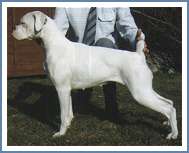 |
More than this, Jane, as she was to be called, looked very like a Boxer, both as a small pup and subsequently when she reached normal Boxer size (Fig. 14). And her temperament was delightful, being Boxer in most ways if perhaps more sweet and
gentle. In effect, we had got our "Boxer" back in the first backcross generation.
But there were other points of interest. Ear carriage and mouths were checked at later ages. Of 11 pups examined at 10 months, 4 had the stiff "cardboard" ears that could partially or completely stand erect (Fig. 15).
|
Fig. 14 Jane, the first bob-tail 'Boxer' at 12 months. Boxer white, long legs, short coat, bob-tail. Compare her with her mother, Dolly, Part 1, Fig. 6.
|
|
This did not include our selected long legged, bob-tail, white bitch, but the 4 stiff eared ones were bitches, giving me thoughts on creating an erect eared Boxer. Six of the 11 were also undershot (including Jane), even if they were narrow of jaw. But with the teeth large and regularly placed. Head types all still tended towards Corgi, but were generally deeper and stronger, with some stop and wrinkle. Size varied considerably, some being quite small while one male was huge weighing in at 80lbs (Fig. 16).
Coat type was rather confusing. At about 8 weeks there appeared to be two coat types which I assumed would develop either as long coated like the crossbred dams, or short coated like the Boxer sire. But at 10 months there appeared to be several coat lengths. One dog was very
short coated, as are many Boxers, several others fell within what I would still consider the normal Boxer range, but the remainder were definitely on the long side with some wave, although not nearly as long or as wavy as that of the dams. Contrary to the indications in the literature, therefore, more than a single gene seems to be involved in coat length and type.
|
Fig. 15 Erect to semi-erect ears
in a first backcross bitch
at 10 months.
|
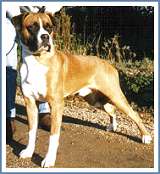
|
Fig. 16 An 80lb dog
at 10 months. |
In all the excitement of the Borgy breeding, the scientific component of the study was not forgotten. Blood samples have been collected from the original Boxer and Corgi parents, from all the first cross progeny, from our Boxer male (Foreign Service) used in the backcross and from nearly all of the 16 backcross generation pups. When I get blood samples from the remainder, Dr Jeff Sampson from Leicester will make DNA from them for analysis. Half of this DNA will be used in Cambridge as part of the UK Canine Genome Mapping Project and half will be sent to California where a similar programme with different genetic markers is in progress. The same collection procedure will be followed in
subsequent generations as appropriate.
WHAT NEXT?
The surprising discovery at this stage was that few genes seem to distinguish two such diverse breeds as the Boxer and Corgi. Apart from those concerned with head properties, these specifically include those for leg and coat length.
The presence of finer points that distinguish the Boxer from other breeds could still be said to be variably evident however.
Thus, so far as even the most Boxer-like dogs from the first backcross were concerned, there still seemed to be something foreign about them. In the case of Jane, further development of head was required, she needed a larger eye, stronger and harder musculation, a shorter, harder coat and more bone. So, further improvements were needed, but perhaps little more than those involved in the ordinary task of trying to breed good show animals.
Fortuitously, because of the dominant inheritance of the main unwanted characteristics (short legs and long coat), there was no need to worry about these appearing in
Jane's descendants. She had the long legs and a short coat and therefore did not carry the short leg and long coat genes, and so could not transmit them. All that needed to be done was to breed selectively over a further generation or two of backcrossing the bob-tail gene into the Boxer to create a bob-tailed but otherwise typical "Boxer". And, this might be achieved in a single further generation, with a judicious choice of sire and a little bit of luck.
THE SECOND BACKCROSS: OBJECTIVES AND EXPECTATIONS
In this generation there were just two objectives in addition to retaining the bob-tail gene; the improvement in breed type plus show points, and re-establishing the accepted colour.
For our selected bob-tail bitch, Jane, we needed a stud dog excelling in breed type, size and substance and with good head and eye qualities. And, as usual in choosing a stud dog, he had to be of good show quality. Finding such a dog would not be easy, and then there was the issue of colour.
Trivial as this is, it was a critical point. The possibility of getting a white puppy with all the other characteristics wanted, but then found to be deaf, was a horrendous thought. Therefore, priority was given to ensuring that all the pups would be coloured. If colour had been the only consideration, this could easily have been resolved through the use of any "solid" stud dog, that is, one which does not carry the gene for white
(identified by white markings on the limbs confined to the toes). Such a dog when mated with a white
would produce only flashily marked pups, carrying only a single dose of the responsible gene.
The problem in practice was that, as almost all show dogs are flashily marked and therefore carry the gene for white, finding a solid dog of show quality, and with the specific characteristics needed would be difficult. In addition, would a committed breeder of show stock allow any significant stud dog to be used on a crossbred bitch?
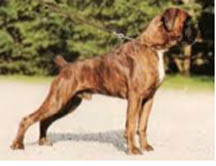 |
|
Fortunately, there are people in Boxers who are as wrapped up in the breeding of animals as I am. Enquiry quickly raised two breeders who had potentially suitable dogs and were willing to participate in the project. The MacLarens from Scotland had a suitable dog but he was still too young at the time Jane came into season. However, the Rallings had a dog with absolutely all the requirements. The dog, Boxella's Chief of Zenmaxkay (Fig. 17), is a Continental import of outstanding German - Dutch parentage. |
Fig. 17 Boxella's Chief at Zenmaxkay,
the 'solid' dog mated to Jane. |
Not surprisingly for this breeding he is big substantial male, excelling in bone substance and above all breed type. More than this he has produced progeny which excel in head qualities and which have notably good eye shape and size. And, as well as qualifying as a solid on the basis of his limited white markings, it was clear from his past breeding performance that he did not produce whites; he did not carry the gene. A brindle, he was known to carry the gene for red/fawn.
In summary, the expectations for the litter were as follows:
- all the pups should be coloured and have flashy white markings within the recognised Boxer range. There would be no whites, solids or piebalds;
- half the litter should be brindle like the sire and half should be red/fawn, Chief being a carrier of red and Jane being a red/fawn "under" the white, as indicated by her two tiny spots of red/fawn coat;
- half the litter should inherit the bob-tail gene from Jane and be bob-tails, while the rest would have normal length tails;
- all the pups should look like Boxers, with no "throwbacks" to the dominant Corgi characteristics (short legs, long coat); and,
- head types, hopefully, would be much improved and, barring any total surprises, these should fall within the range exhibited by the parents.
Stud arrangements were made, and when Jane came into season at about 18 months old, she was duly mated to Chief. Being of normal Boxer height there was no difficulty in mating her.
Part 3 of this article, will describe the outcome of the mating and consider future options.


:Home: :About: :Champion Boxers: :Other dogs of Note: :Photo Gallery: :Bobtail Boxers:
:Bobtail Gallery: :Genetics: :Links:
:Guestbook: :Email:
|
Site design by
Webpage World
| |

